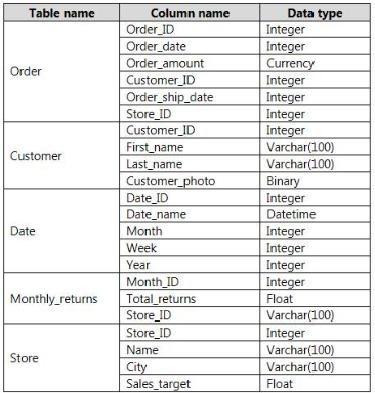Note: This question-is part of a series of questions that use the same scenario. For your convenience, the scenario is repeated in each question. Each questionpresents a different goal and answer choices, but the text of the scenario is the same in each question-in this series.
You have a Microsoft SQL Server database that contains the following tables.

The following columns contain date information:
• Date[Month] in the mmyyyy format
• Date[Date_ID] in the ddmmyyyy format
• Date[Date_name] in the mm/dd/yyyy format
• Monthly_returns[Month_ID] in the mmyyyy format
The Order table contains more than one million rows.
The Store table has a relationship to the Monthly_returns table on the Store_ID column. This is the only relationship between the tables.
You plan to use Power BI Desktop to create an analytics solution for the data.
You plan to create a chart that displays total Order[Order_amount] by Store[Name].
You need to modify the model to ensure that you can create the chart.
Which two actions should you perform? Each correct answer presents part of the solution.
NOTE: Each correct selection is worth one point.
A. Create a relationship between the Order table and the Store table.
B. To the Order table, add a measure that uses the COUNTA(‘Order'[Order_ID]) DAX formula.
C. To the Order table, add a column that uses the RELATED(‘Store'[Store_ID]) DAX formula.
D. To the Order table, add a measure that uses the COUNT(‘Order'[Order_amount]) DAX formula.


What does adding RELATED(‘Store'[Store_ID]) to the Order table have to do with the solution for this? The Order table already has a Store_ID field. It looks to me there should be a D option with the measure SUM(‘Order'[Order_amount]).